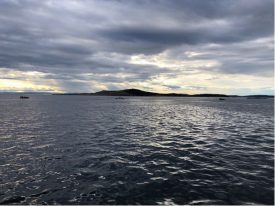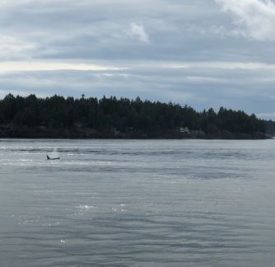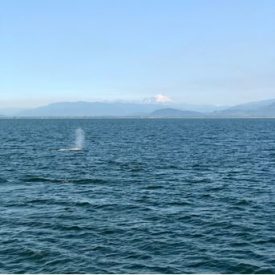SMEA Summer: Watching people watch whales
By Celeste Barnes-Crouse

Boats, binoculars, and big whales: a recipe for my thesis research. When I came to SMEA, I knew I wanted to write a thesis to complete my degree. I knew it would be challenging, but I liked the idea and flexibility of designing my own research and contributing new information to the literature. I planned for my research to take place over the summer of 2018, and if I was going to be spending hours doing it then I wanted to like what I was doing.
Anyone who knows me can tell you that I am obsessed with whales. This obsession started when I was 11 years old on my first whale watching tour. I learned all about whale biology and ecology from a naturalist on board. I didn’t know at the time that this interpretation by a naturalist is a form of science communication. Today, this is a field I’m passionate about and it’s still a key component of whale watching tours operating out of Washington State. So, I decided to combine my interests and study science communication in the setting of whale watching boats in the Salish Sea.

Whale watching boats are a great setting for this because they contain a captive audience of highly motivated people who have spent time and money to have an exceptional experience. These factors combine for a prime opportunity for effective science communication. This can help us bridge the gap that exists between the scientific community and the general public to get people interested in science, enhance their ability to understand it, and encourage them to engage with it in their daily lives.
So, what does science communication aboard whale watching boats look like today? Is it effectively connecting people with relevant information? Do people enjoy learning from their whale watching tours? These are just some of the questions I’m seeking to answer with my research. Stay tuned for my thesis, coming in spring 2019!

Photo by Celeste Barnes-Crouse.
My research days involved joining whale watching tours to observe the naturalists’ presentations and the whale watchers. I wanted to find out what information was being shared, how it was presented, and how the passengers were reacting to it. Amidst the “oohs” and “aahs” of the other passengers, I would roam around the boat with my waterproof notebook and take notes while the people around me snapped pictures of whales and listened to the naturalist. At the end of the tour, I would distribute pen-and-paper questionnaires to ask people about their experiences of the day. I would come home with a backpack full of questionnaire responses and a heart full of happiness from seeing whales.
This brings us to today, where I have an Excel spreadsheet with hundreds of answers to my questions and a lot of data crunching left ahead of me! But I have no complaints because I got to be outside, see whales, learn new things, and grow as an academic. While I did have to work hard this summer, this also served as a reminder of what a summer in the Pacific Northwest can offer, and I got to experience the best of it. It is such a gift to have this wonderland as my classroom!